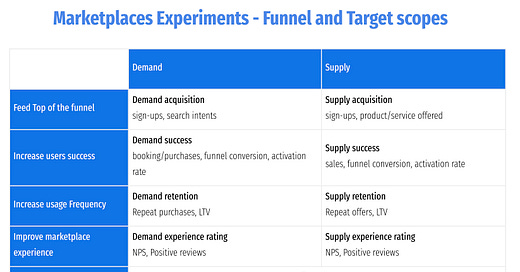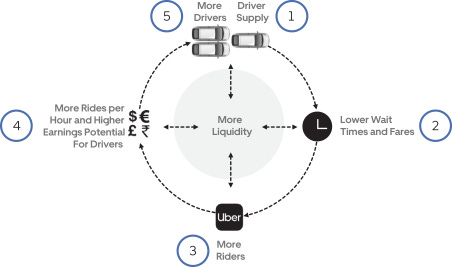👋 Hi there, it’s Pierre-Jean. Welcome to this new edition of The Growth Mind!
Every 2 weeks, I share Growth strategies inspired by the world’s leading scale-ups. To help you build outstanding Growth knowledge.
Today, we’re going to analyze 3 powerful experiments for marketplaces:
👋 Reducing price for Newcomers
🏅 Proposing a loyalty program for regular users
📊 Adapting price to demand
But before deep diving into those 3 experiments, let’s first define how marketplaces operate and their main challenges.
How Marketplaces Operate: Unfolding Their Business Model
Matching demand and supply to achieve the desired outcome
A marketplace is a platform that aims to match 2 groups of people or businesses:
Supply: people or companies offering a good or service.
Demand: people or companies seeking to purchase that good or service.
The role of marketplaces is to create a platform where those two groups can meet, interact and transact.
Marketplaces operate on a simple but effective business model: they earn a commission on each transaction.
This commission can be either a percentage of the transaction or a fixed fee, quantified by a metric called take-rate (the percentage of the transaction's value that the marketplace earns).
This is a sharp and scalable business model.
Some marketplaces can be three-sided, with an additional actor (doing the delivery for example) operating.
In recent years, we saw many successful marketplaces emerge:
Airbnb, in the tourism industry, who is matching Hosts proposing an accommodation (supply) with Guests (demand).
Uber, in the mobility industry, is matching professional drivers (supply) with passengers (demand) to make a ride.
Deliveroo, in the food industry, matches restaurants (supply) with people wanting to order food (demand). You can add a 3rd side of the marketplace here: the delivery men.
BlaBlaCar (the company where I work), in the mobility industry too, makes drivers publish carpool trips (supply) on the platform, that can be booked by passengers (demand).
Chicken-egg problem and network effects
One of the main challenges of marketplaces is to match supply and demand efficiently. To do that, they need a sufficient amount of users on both sides of the marketplace.
In the beginning, every marketplace suffers from the chicken-egg problem: there is no supply, so demand does not come. And there is no demand, so supply does not come.
The main objective then is to have sufficient liquidity to make demand and supply come to the marketplace. With sufficient liquidity, marketplaces start to benefit from network effects.
Network effects mean that the more users the marketplace has, the more the product becomes valuable. So by growing, the marketplace delivers a better service and benefits from scale economies. Providing a better service unlocks more growth. The flywheel becomes unstoppable.
Consider Uber Network Effects:
With a large supply of drivers, wait times decrease, ensuring a smooth experience for passengers.
On the other hand, with a large demand, drivers are regularly contacted to take passengers and then make more earnings.
It’s a virtuous cycle where everyone benefits from a large amount of Supply and Demand.
Network effects are one of the reasons we see many successful marketplaces.
But don’t get me wrong: starting a marketplace is really difficult. All the successful marketplaces we have today started with a great product/market fit and an amazing ability to scale.
To learn more about the network effects concept, I recommend “The cold start problem” book, written by Andrew Chen, a partner at the famous Venture Capitalist Andreessen Horowitz.
Let's now move to our main topic - the 3 powerful experiments for marketplaces.
3 powerful experiments for Marketplaces
Experimenting on marketplaces can be done on several parts of the funnel, and target both demand and/or supply.
This table has been designed to visualize:
The Funnel areas where you can experiment on a marketplace
The metrics you’ll try to impact for each funnel area, depending if your experiment is targeting Demand or Supply.
If you’re running a marketplace, consider adapting this table to your business specificities.
Experiment 1: Reducing Price for Newcomers 👋
Objective: The aim here is to feed the top of the funnel by making your offer more attractive to newcomers.
Experiment Description: This could be implemented as a first-time user discount, where new users are offered a significant percentage off their first transaction. The discount code could be sent immediately after sign-up to incentivize users to make their first transaction as soon as possible. You might also consider a sliding discount scale - the more new users spend, the larger discount they receive, incentivizing larger initial transactions.
Success Criteria:
An increase in new user sign-ups and then transactions.
An increase in overall revenue. If the discount is successful, the incremental revenue from the additional new users should more than cover the cost of the discount.
Complexity: Low
Target: Demand
Example: Uber eats with regular promo codes for first-time users, used to boost acquisition. The food delivery industry is a winner-takes-all market, where two or three companies dominate the industry. That’s why rapidly increasing acquisition has been chosen by Uber Eats.
Experiment 2: Introducing a Loyalty Program for regular users 🏅
Objective: The goal here is to improve retention by incentivizing regular users of your marketplace.
Experiment Description: This could be a tiered rewards program where users earn points or credits for each transaction, which can then be redeemed for future purchases or exclusive perks. The tiers could be based on the frequency or total value of transactions, and each tier could offer increasingly attractive benefits - from small discounts all the way up to VIP services or experiences.
Success Criteria:
A decrease in churn rates. If the loyalty program is successful, you should see more users sticking around for longer.
An increase in repeat purchases or bookings. This indicates that the program is effectively encouraging users to choose your platform over competitors.
Positive feedback and high satisfaction scores from users. This qualitative measure can provide additional validation that your loyalty program is hitting the mark.
Complexity: Medium
Target: Supply
Example: Lyft with a program for their drivers, rewarding them with points that give access to exclusive deals related to car maintenance. This is a great way for Lyft to incentivize drivers to work with them rather than Uber.
Experiment 3: Adapting Price to Demand 📊
Objective: The purpose of this strategy is dual. In periods of low demand, the aim is to maximize transaction volume by lowering prices. Conversely, during high-demand periods, the goal is to maximize revenue by increasing prices. A dynamic pricing algorithm can accomplish this delicate balancing act.
Experiment Description: This strategy would require the implementation of a dynamic pricing algorithm that adjusts prices according to demand. You’ll need to collect and analyze data on when demand is typically high or low and set the algorithm to raise or lower prices accordingly. For instance, you could decrease prices during traditionally slower periods to stimulate demand, and conversely, increase prices during peak times to capture maximum value. This could be influenced by factors such as time of day, day of the week, seasonality, or special events.
Success Criteria:
For low demand periods: An increase in transaction volume. If the strategy is successful, lower prices should stimulate demand and lead to a higher number of transactions.
For high-demand periods: An increase in revenue. Higher prices should generate more revenue, indicating that the strategy is working.
Balance in supply-demand. If the supply remains steady or increases in response to shifting demand, it indicates that the price adjustments are not negatively affecting the supply.
Stable or increased user NPS. Even with fluctuating prices, high satisfaction scores indicate that users see the value in your service and are willing to pay accordingly.
Complexity: High
Target: Supply & Demand
Example: Getaround with a smart pricing feature, helping their car renters to earn up to 20% more revenue. Based on historical and dynamic data, Getaround proposes prices adapted to the season, making sure people who rent their car get the most out of their product.
Those 3 experiments have proven to be powerful for marketplaces in the past. If you’re running a marketplace, those are great inspirations to learn from.
However, be careful of always adapting those experiments to your business specificities. This is not because an experiment has worked for a marketplace that will work for yours.
There is also a bunch of other experiments you could consider to retain users, establish network effects, and maximize revenue.
Experimentations can lead to unlocking new growth levers and learnings. As always, experimenting comes with data. To measure the success or failure of an experiment, make sure to define properly your success criterias and the metrics you’ll track.
That’s all for today! Congrats on reading this article, you did it!
See you in 2 weeks for the next edition of The Growth Mind. 👋










